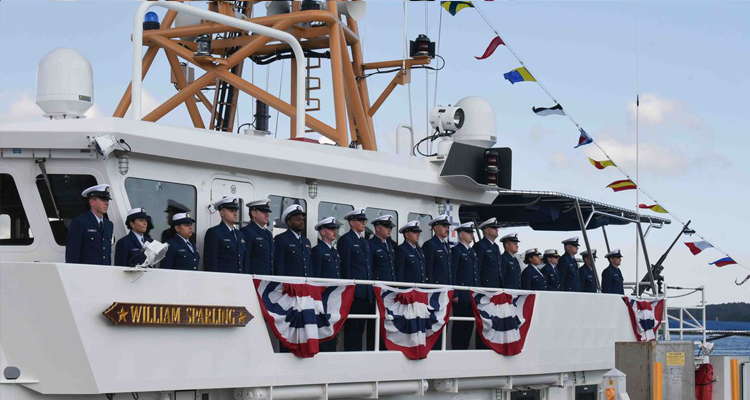Oct. 23, 2023 —

Crewmembers of Coast Guard Cutter William Sparling man the rails as the cutter is placed into commission during a ceremony in New Castle, New Hampshire, Oct. 19, 2023. The cutter is the 54th fast response cutter (FRC) in the Coast Guard fleet and will be the fifth FRC to be stationed in Boston. U.S. Coast Guard photo by Petty Officer 3rd Class Lyric Jackson.
The Coast Guard commissioned its newest fast response cutter (FRC), Coast Guard Cutter William Sparling, Oct. 19, 2023, at Station Portsmouth Harbor in New Castle, New Hampshire. This is the fifth of six planned Sentinel-class FRCs to be homeported in Boston and the 54th to be commissioned.
The cutter’s namesake, William Allerton Sparling, was one of the first Coast Guard enlisted members to be awarded the Silver Star Medal, one of the nation’s highest military awards for valor in combat. Sparling served as a landing craft coxswain during the Battle of Tulagi, a strategically important island in the Pacific theater, during World War II.
Allied forces arrived at Tulagi on Aug. 7, 1942, to reestablish control of the island, which had been captured by enemy forces in May of that year and served as a potential threat to Allied unites and supply routes in the region. The amphibious assault, supported by the landing craft piloted by Sparling and other coxswains, was the first U.S. offensive of World War II and was one of the first in a series of battles that defined the Guadalcanal campaign. During the invasion, Sparling and other coxswains landed the first wave of U.S. Marines on the beaches of Tulagi. Over the next three days of fighting, Sparling and others made repeated trips to deliver equipment, ammunition and other supplies to Marines as they engaged a determined occupying force of 800 troops. On Aug. 9, the remaining enemy forces surrendered, and the Allies successfully secured Tulagi.
Sparling’s widow, Caroline Sparling, was in attendance and was the cutter’s sponsor. Ellen Burns Gemma, Sparling’s niece, attended and presented the long glass to the crew, officially setting the first watch aboard ship. “I feel a sense of tremendous pride and respect for each of you who will serve to carry out the U.S. Coast Guard’s strategic roles and missions of ensuring the safety, security and stewardship of our nation’s waters and far beyond,” Gemma said. “Please know the many Sparling family members and other relatives of Bill are deeply touched by this incredible honor.”
The FRC is designed for multiple missions, including drug and migrant interdiction; ports, waterways and coastal security; fishery patrols; search and rescue; and national defense. The FRCs feature advanced command, control, communications, computers, intelligence, surveillance and reconnaissance equipment; over-the-horizon cutter boat deployment to reach vessels of interest; and improved habitability and seakeeping.
The Coast Guard has ordered a total of 65 FRCs to replace the 1980s-era Island-class 110-foot patrol boats. Of the 54 now in service, 13 are in Florida; seven in Puerto Rico; six in Bahrain; five in Massachusetts; four in California; three each in Alaska, Guam, Hawaii, Texas and New Jersey; and two each in Mississippi and North Carolina. Future FRC homeports include Astoria, Oregon, and Kodiak and Seward, Alaska.
For more information: Fast Response Cutter Program page.